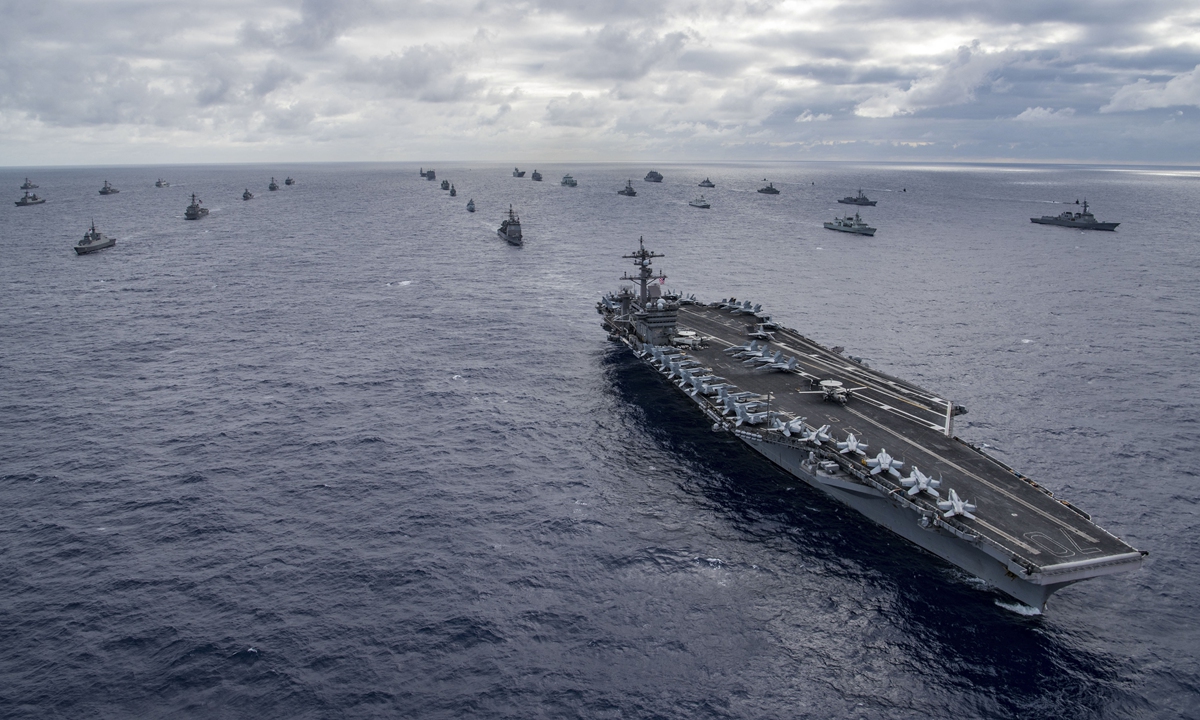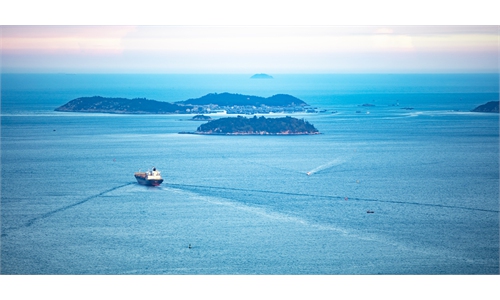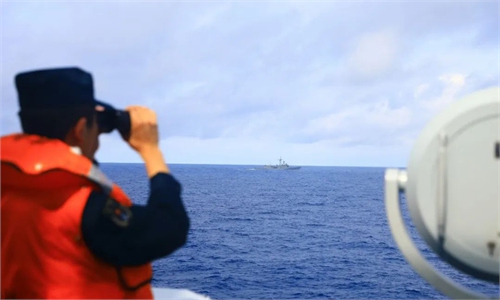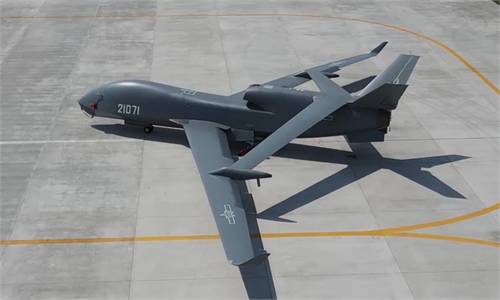
International Navy ships assemble off the coast of Hawaii during the Rim of Pacific Exercise (RIMPAC) on July 26, 2018. Photo: AFP
The US-led Exercise Rim of the Pacific (RIMPAC) 2024 was scheduled to kick off on Thursday, with a key part of the drills being sinking a 40,000-ton target ship that analysts said aim to show off the capability to destroy a Chinese amphibious assault ship or aircraft carrier amid current tensions in the Taiwan Straits and the South China Sea.
Inciting bloc confrontation, such drills will only sabotage, not safeguard, peace and stability in the region, and China will firmly safeguard its national sovereignty, territorial integrity and development interests regardless of Western intimidation, experts said.
The Nimitz-class aircraft carrier USS Carl Vinson has arrived at Joint Base Peral Harbor-Hickam for RIMPAC 2024, the US Pacific Fleet announced on social media platform X on Thursday.
Some 40 surface ships, three submarines, 14 national land forces, more than 150 aircraft and 25,000 personnel from 29 countries are participating in RIMPAC in and around the Hawaiian Islands from Thursday to August 1, the US Pacific Fleet said.
The RIMPAC 2024 will include multi-domain warfare in a range of scenarios from anti-submarine warfare, multi-ship surface warfare, multinational amphibious landings, and multi-axis defense of the carrier strike group against live forces, the news website of the US Naval Institute reported on Wednesday.
As a biennial event, this year's RIMPAC is of a slightly larger scale than the previous RIMPAC in 2022, which involved 25 partner countries, 38 surface ships, three submarines, nine national land forces, approximately 170 aircraft and more than 25,000 personnel, according to the US Naval Institute.
One of the highlights of the RIMPAC 2024 is set to be the sinking of the ex-USS Tarawa, a decommissioned 40,000 ton-class US Navy amphibious assault ship, as a live target, VOA reported on Wednesday.
VOA said the plan to use the ex-USS Tarawa as a target ship in the RIMPAC 2024 is aimed at countering China's development of large amphibious assault ships and aircraft carriers, and their potential deployment around the island of Taiwan.
The Chinese People's Liberation Army (PLA) Navy has commissioned three Type 075 amphibious assault ships, with a fourth reportedly under outfitting. These vessels are roughly of the same size as the ex-USS Tarawa, and the core message is that the US and its allies can quickly sink a Type 075, VOA quoted a US analyst as saying.
VOA also noted that China is reportedly building an even larger amphibious assault ship dubbed the Type 076, which is equipped with a catapult to launch drones and other fixed wing aircraft.
In response, Senior Colonel Wu Qian, spokesperson of China's Ministry of National Defense, told the Global Times at a regular press conference on Thursday that Taiwan is an inalienable part of the Chinese territories, and resolving the Taiwan question is an own matter of the 1.4 billion Chinese people that brooks no external interference.
It is impossible for the US to frighten the Chinese military through the so-called drills, Wu said.
Chinese military expert Fu Qianshao told the Global Times on Thursday that there are obvious implications that the RIMPAC 2024 is pointed at China, as there are not many countries in the Asia-Pacific region that operate amphibious assault ships and that are not US allies.
Using a 40,000 ton-class amphibious assault ship as a target can of course simulate an attack on an amphibious assault ship, but also practice an attack on an aircraft carrier, Fu said.
Observers said amphibious assault ships and aircraft carriers are important instruments of the PLA in solving the Taiwan question and the South China Sea issue, as amphibious assault ships can host multidimensional landing on islands and reefs by carrying a large number of helicopters, air-cushioned landing craft, amphibious armored vehicles and troops, while aircraft carriers can seize air superiority and control of the sea.
China's amphibious assault ships and aircraft carriers are not built to serve the sole purpose of resolving the Taiwan question or the South China Sea issue, but should countries from outside the region interfere, they will have to be deployed to defend China's sovereignty, territorial integrity and development interests, experts said.
Large military vessels such as amphibious assault ships and aircraft carriers are valuable military assets that are built to be difficult to sink, so using a genuine ship as a target can gather rare data, observers said.
There were foreign news reports claiming that China sent surveillance ships to monitor previous RIMPAC exercises.
When an exercise is so pointed at China, it is only natural that China will closely monitor it, Fu said. The drills will give China a chance to learn what methods and tactics the US and its allies will use against amphibious assault ships and aircraft carriers, so that China can find ways to counter, he said.
True intention
Zhang Junshe, another Chinese military expert, told the Global Times on Thursday that the US' real intention of rallying so many countries and hosting the RIMPAC 2024 is not to safeguard peace and stability in the Asia-Pacific region, but to force them into joining this US-led clique and serve the US' so-called Indo-Pacific Strategy that aims to contain its competitors.
However, most countries, even those participating in the exercise, do not want to follow the US in this bloc confrontation, nor are they willing to interfere militarily in the Taiwan question or the South China Sea issue, Zhang said.
Such intimidations will not scare the Chinese people or the PLA, as the Chinese military will firmly safeguard China's national sovereignty, territorial integrity and development interests, Zhang said.




